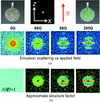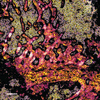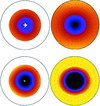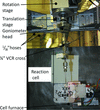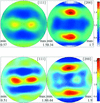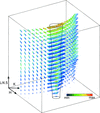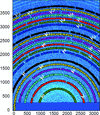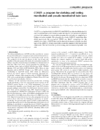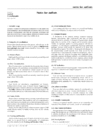issue contents
February 2014 issue

Cover illustration: Colour-coded intensity map of a time-resolved small-angle X-ray scattering experiment following the osmotic shrinkage of a pharmacologically relevant liposomal system. Courtesy of Varga et al. [J. Appl. Cryst. (2014), 47, 35-40].
editorial
Free 

Journal of Applied Crystallography is pleased to announce a virtual issue presenting articles based on some highlights of the 15th International Small-Angle Scattering Conference (SAS2012) This special issue collects together a series of articles originally published in the journal between October 2013 and February 2014 and is available at //journals.iucr.org/special_issues/2014/sas2012/.
scientific commentaries
Free 

Nuclear waste management is an important challenge. Small-angle neutron scattering, transmission electron microscopy and mercury intrusion porosimetry have been brought to bear on the level of waste incorporation in cement and its impact on its mesoscopic structure. These results lead to a recommended limit for waste incorporation to avoid leaching out of the waste, clearly an undesirable property.
research papers
The guest exchange process in co-crystals of syndiotactic polystyrene has been studied by in situ time-resolved small-angle neutron scattering measurements, exploiting the scattering length difference between fully protonated and deuterated guest molecules. From the intensity change of lamellar reflections, the diffusion coefficients of guest molecules in the crystalline region could be evaluated.
To clarify the formation of stereo-complex crystals of poly(L-lactic acid) and poly(D-lactic acid) blends under shear flow, the structure was analyzed using time-resolved in situ X-ray scattering, optical microscopy, differential scanning calorimetry and viscoelastic measurements. Density fluctuations of 100 nm scale were observed prior to nucleation by in situ simultaneous wide- and small-angle X-ray scattering measurements.
Thermosensitive charged triblock copolymers have been investigated using SAXS. It was found that the temperature response of the micelles formed at elevated temperatures is dependent on the nature of the charged group.
Scattering experiments with nano- and micrometre sized X-ray beams and a filtration setup with silicon micro-sieves as membranes are reported. As a result of the filtration forces, spherical casein micelles assume an ellipsoidal shape while their volumes remain constant.
The osmotic water permeability and changes in the bilayer structure during the osmotic shrinkage of a pharmacologically relevant liposomal system have been studied using time-resolved small-angle X-ray scattering.
Compound refractive lens focused small-angle neutron scattering was applied to the magnetic chaining technique of force measurements between the particles of a monodisperse ferrofluid emulsion. The analysis required careful treatment of resolution effects and also revealed chain transverse correlations indicating the formation of transient intermediate structures at lower applied fields.
Self-assembled structures of a Pluronic F127 triblock copolymer with an organic derivative in an aqueous solution are reported.
Anomalous small-angle X-ray scattering (ASAXS) is applied to structurally characterize the hindered growth process of CaF2 nanocrystals in an SiO2-based oxide glass resulting in a transparent glass ceramic.
The effect of additive on the nanostructure of a calcium-based hydrogen storage material investigated using anomalous small-angle X-ray scattering and X-ray absorption spectroscopy is reported.
Zinc oxide network structures resembling a foam-like morphology are synthesized via a sol–gel route using a structure-directing diblock copolymer with different molecular weights. Grazing-incidence small-angle X-ray scattering has been used to study the variation in porosity and the average pore size of the films, thereby enabling fine tuning of the morphology depending on the final application.
A versatile procedure to build high-symmetry objects and calculate their corresponding theoretical small-angle scattering intensity is presented, enabling the modelling and fitting of experimental data for very complex models.
The development of combined simultaneous infrared spectroscopy and X-ray diffraction/pair distribution function measurements is presented.
Grazing-incidence small-angle x-ray scattering combined with transmission electron microscopy have revealed the growth temperature effect on the structure of CoPt islands on NaCl(001).
Scanning small- and wide-angle X-ray scattering transmission microscopies are combined with circularly polarized light microscopy to investigate bone biopsies from six coxarthritis-affected patients, aged 62–87 years. The results suggest the existence of a correlation between age and cross-linking-induced rigidity of collagen fibers.
A scattering formalism optimized for periodic lattices of nano-objects is described. This formalism allows for arbitrary anisotropic nanoparticles assembled into homogeneous or heterogeneous superlattices. Various kinds of disorder are considered, allowing detailed fitting of experimental data for nanoparticle superlattices.
Time-of-flight grazing-incidence small-angle scattering is applied to a solid–liquid boundary. In a single-shot experiment, depth-resolved structural information is obtained for a micellar block polymer crystal.
Accuracy in amorphous quantification of samples with dominant amorphous content, reproducing zircon-rich sanitary-ware glazes, has been investigated
Probing temperature- and solvent-dependent protein dynamics using terahertz time-domain spectroscopy
The effect of temperature on the terahertz-frequency-range material properties of hen egg-white lysozyme is measured using terahertz time-domain spectroscopy.
A new approach for the determination of the elastic macro strain and stress in textured polycrystals by expanding the texture-weighted strain tensor in a series of generalized spherical harmonics is presented. The model ground state is defined by the strain/stress state in an isotropic sample in the Voigt model.
Small changes in atomic coordinates caused by internal stresses in doped single crystals are investigated. Invariant phases are measured via X-ray multiple diffraction experiments.
Statistical measures for quantifying the spottiness of diffraction rings are introduced: the number of peaks, the normalized root mean square intensity variation and the fractal dimension. These are applied by way of example to a corrosion study of mild steel.
Open  access
access
 access
accessThe high-resolution scattering length density analysis method has been generalized from unilamellar to multilamellar lipid vesicles. The method may be applied to X-ray data only, or to a joint analysis of X-ray and neutron data, yielding an improved refinement of the lipid backbone position.
An experimental approach for measuring strain pole figures at the synchrotron SOLEIL during mechanical deformation is described. The article shows the measurements performed on a 40 nm-thick gold thin film supported by a polymeric substrate and submitted to controlled non-equibiaxial loads.
The MAXIC (multiple application X-ray imaging chamber) was developed as a common platform for X-ray free-electron laser single-shot diffraction experiments. Results from single-shot imaging and serial femtosecond crystallographic data collection performed at SACLA (Japan) are introduced.
An extended contrast variation method with fitting formulas is suggested for describing small-angle scattering from multiphase fractals.
A cluster algorithm is described and applied to automate the extraction of surface X-ray diffraction data collected with an area detector. A method for utilizing the full field of area detectors to measure weak or diffuse scatter is outlined. Combined, these methods improve the reliability of, and lead time to, a structural solution.
Download citation


Download citation


The structure of a complex pseudo-decagonal quasicrystal approximant [Al37.0(Co,Ni)15.5, PD2] has been solved using the new three-dimensional rotation electron diffraction method.
CCDC reference: 968428
Different forms of two-dimensional graphenic nanoplatelets can be tailored by modulating the methodology of unzipping single-walled carbon nanotubes. The existence of an unstable orthorhombic phase of graphite has been detected using electron diffraction in both reflection and transmission configurations.
The surface treatment of protein crystallization plates can increase the likelihood of obtaining protein crystals in an inexpensive and convenient manner.
A broad and dynamic range of momentum transfer Q can be accessed down to 10−3 Å−1 at the new small-angle neutron scattering instrument V16/VSANS at the Helmholtz-Zentrum Berlin, Germany. The time-of-flight option in combination with variable chopper configurations provides tailored experimental setups optimized for accuracy and range in Q as well as for neutron flux.
A high-pressure–high-temperature gas-loading system has been developed for combined in situ high-energy X-ray diffraction and mass spectrometry investigations during catalysed gas/solid or liquid/solid reactions. The benefits of such a system are the combination of different gases, the flexibility of the cell design, the rotation of the cell, and the temperature, pressure and gas-flow ranges accessible. This opens up new opportunities for studying catalysts or compounds not just from a fundamental point of view but also for industrial applications, in both cases in operando conditions.
The shape of reciprocal space maps from GaN epitaxial films is explained as a natural consequence of the presence of both misfit and threading dislocations.
A method for the deconvolution and restoration of Kikuchi bands is presented.
A new approach for indexing multigrain diffraction data is presented.
X-ray single-mode diffraction is achieved using wide-angle incidence and grazing-emergence diffraction from a bare Si substrate and from Si nanowires on an Si substrate.
A convenient, efficacious stress analysis for highly planar-faulted, fibre-textured films is presented, separating the fault-induced and the stress-induced diffraction-peak shifts. This method is applied to an Ni(W) film during tensile testing, highlighting the enormously enhanced stiffness and strength compared to a pure Ni film.
This work presents a detailed microstructure and texture study of various hydrided Zircaloy-4 materials by neutron diffraction and microscopy.
Nitrogen sorption and small- and wide-angle X-ray and neutron scattering techniques were used to study the porous structure of sodium and potassium geopolymers.
Download citation


Download citation


A study by neutron diffraction, thermogravimetry and electrical resistivity shows that the cationic order in the tetragonal LaBaCo2O6−δ perovskite phase induces a major concentration of oxygen vacancies in the LaO layers and losses in dimensionality for the transport of oxygen-ion and electron-hole charge carriers compared to the cationic disorder in the cubic La0.5Ba0.5CoO3−δ phase.
The objective of this article is to develop and apply a model for the design and evaluation of X-ray diffraction experiments to measure phase-specific residual stress profiles in multilayer systems.
An implicit embedding of the space of Niggli-reduced cells in a higher-dimensional space to facilitate calculation of distances between cells is described. This distance metric is used to create a program, BGAOL, for Bravais lattice determination. Results from BGAOL are compared with results from other metric based Bravais lattice determination algorithms. This embedding depends on understanding the boundary polytopes of the Niggli-reduced cone N in the six-dimensional space G6.
A database of lattices using the G6 representation of the Niggli-reduced cell as the search key provides a more robust and complete search than older techniques. Searching is implemented by finding the distance from the probe cell to other cells using a topological embedding of the Niggli reduction in G6.
Two integration methods to determine the structure factors along a surface diffraction rod measured with a two-dimensional detector are proposed. A theoretical framework as well as a comparison between integration methods is provided.
A line pattern is observed which overlays all images detected by an X-ray area detector with a single-crystalline sensor layer, as a result of diffraction within the sensor layer itself. The intensity of the detected signal is decreased by up to 20% on this pattern. Potential applications such as photon energy calibration and angular alignment are discussed.
Among the different kinds of equation of state (EoS), the Vinet EoS is believed to be one of the most accurate, providing correct results for different material systems up to very high compression ratios. In order to invert the Vinet EoS analytically, a Taylor series expansion truncated to third order can be used, which allows a direct application in parametric refinement of powder diffraction data.
This work provides a report of synchrotron diffraction investigations dedicated to the measurement of the experimentally observable diffraction-line broadening induced by external elastic loading of various polycrystalline specimens. The experimentally obtained broadening data have been compared with those calculated adopting various grain-interaction models.
A new reciprocal-space vector method is developed, which provides a practical and concise route to crystal structure studies of epitaxial thin films.
Download citation


Download citation


Neutron diffraction is used to analyse the structure of ferrite nanoparticles obtained by microwave-assisted growth. A comparison with respect to the results obtained with the thermal synthetic route is needed to check the efficiency of the microwave synthetic methodology.
Small-angle neutron scattering is used to set the maximum limit of chemical waste immobilization in a cement matrix.
Finely tuned protein deuteration enabled selective observation of small-angle neutron scattering of an intrinsically disordered protein (IDP) captured by a tetrameric molecular chaperone. The data thus obtained provided unique information on the conformational changes of the IDP coupled with interaction with the chaperone, and complemented the NMR approach.
A method is presented to perform neutron diffraction with relatively high resolution using a white beam and Larmor precession to determine the wavelength.
The formation of the antiphase domains and 90° rotation domains are anticipated in the In2O3 thin films grown on yttria-stabilized zirconia (001) substrate using group theory analysis. This prediction is confirmed using transmission electron microscopy experiments.
The performance of a complementary metal-oxide semiconductor (CMOS) detector for high-energy X-ray powder diffraction and total scattering studies has been evaluated. The detector shows great potential at moderate costs for applications at synchrotron beamlines.
short communications
Crystal packing contacts between protein molecules are frequently mediated by a small molecule or by a monoatomic ion that bridges the two molecules, especially when the latter are related by a screw axis. It is therefore reasonable to suppose that the presence of these small molecules/atoms might play an important role in the crystallogenesis.
computer programs
Open  access
access
 access
accessSHELXL2013 contains improvements over the previous versions that facilitate the refinement of macromolecular structures against neutron data. This article highlights several features of particular interest for this purpose and includes a list of restraints for H-atom refinement.
A new computer program which implements left coset decomposition algorithms to derive possible merohedral and pseudo-merohedral twin laws is presented.
laboratory notes
A home laboratory system combining X-ray microtomography and X-ray scattering setups is presented. The system allows the scattering beam to be targeted on a specified sub-volume of the sample on the basis of a previously obtained microtomography reconstruction.
Open  access
access
 access
accessA new simultaneous measurement system for small-angle X-ray scattering and wide-angle X-ray diffraction (SAXS–WAXD) and the thickness of coating films, and a data correction method for the scattering invariant from SAXS during solvent evaporation, are presented. The correction was important when investigating the film formation mechanism on drying.
addenda and errata
Free 

Errors in the article by Mocuta, Richard, Fouet, Stanescu, Barbier, Guichet, Thomas, Hustache, Zozulya & Thiaudière [J. Appl. Cryst. (2013), 46, 1842–1853] are corrected.
international union of crystallography
Free 



 journal menu
journal menu
















